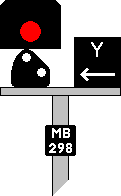Section 11: Indicators and Signs associated with Points
(Page 3 of 3)
|
The 'remote ground frame marker' was introduced in 1996 as part of a proposal aimed at warning drivers in the event of detection being lost at ground frame operated points in remote areas. The marker, which bears a downward pointing black chevron on a square white background [11.43], was positioned on the approach side of the points, in the facing direction. A colour light distant signal would be provided at braking distance on the approach side of the marker. If detection of the points was lost, the distant signal would display a yellow aspect (see [2.106]), and trains would then be required to stop at the marker board. Similar looking signs may be seen at facing points on French railways, but they serve a different purpose. Provision of the remote ground frame marker board was discontinued from 1999.
|
 |
[11.43] Remote Ground Frame Marker.

Area: All Areas
Usage: Low
Status: Obsolescent
|
|
|
In May 2003, signal MB298 on the Down Arrival Line at Mossend Yard was provided with an additional miniature indicator. When the signal is cleared for a route to the Down Yard, the indicator shows a left-hand or right-hand arrow (along with the route indication "Y") to indicate the lie of the facing handpoints ahead [11.44]. The same arrow indication is repeated at the points themselves.
|
 |
[11.44] Handpoints Indication (e.g. points set to left).
Area: Mossend Yard
Usage: Low
Status: Uncertain
|
|
|
In 2003, the original fouling point markers on the West Highland Lines (see [11.39]) were replaced. The new markers comprise a short white post with a yellow reflectorised strip on the side facing away from the relevant points [11.45]. Ironically, just a few days after the markers were replaced, a Class 156 'Sprinter' struck the rear end of a steam-hauled empty coaching stock train that was stopped foul of the crossing loop points at Glen Douglas on 12 June 2003.
|
 |
[11.45] Fouling Point Marker.
Area: West Highland Lines
Usage: Medium
Status: Current
|
|
Some of the American-style handpoints in Bescot Yard are of the non-trailable type. The switch stands that control them have been fitted with indicators to allow the shunter to determine from a distance which way the points are lying. When the points are in the 'normal' position, a white arrow pointing up on a blue background is displayed [11.46]. In the 'reverse' position, the indicator shows a black arrow pointing left or right, on a white background [11.47].
 |
 |
[11.46] Switch Stand Indicator Sign - Normal.
Area: Bescot Yard
Usage: Low
Status: Uncertain
|
[11.47] Switch Stand Indicator Sign - Reverse (e.g. points set to left).
Area: Bescot Yard
Usage: Low
Status: Uncertain
|
|
In October 2006, ground-mounted points indicators were installed on each approach to a particular set of points at Kings Heath Traincare Depot in Northampton. Separate indicators were provided for both the facing and trailing directions. In common with the earlier forms of electrical points indicators, a yellow light is exhibited when the associated points are in the correct position (see [11.36]). These new indicators conformed to a revised standard that required a red light to be exhibited when the points are incorrectly set [11.48]. This provided a positive 'stop' indication, in contrast to the earlier indicators where no light meant 'stop'. Two points indicators displaying similar indications were provided at Bourne End (Western Route) in February 2008.
|
 |
[11.48] Points Indicator - 'Stop' indication.
Area: Various
Usage: Low
Status: Obsolescent
|
|
In December 2008, the position light type points indicators (see [11.37]) at Tenby were experimentally replaced by new indicators showing either a steady yellow light (see [11.36]) or, when the points are incorrectly set, a flashing red light [11.49]. Flashing red became a new standard indication to be displayed by future points indicators. Where a points indicator is co-located with a TPWS indicator at a stop board (see [12.26 & 12.27]), both are combined as a 'Departure Direction Points Indicator' (DDPI). The points indicator in this case has no yellow light, and the plate worded "points indicator" is usually omitted [11.50]. When the points are correctly set, the flashing red light is extinguished and the TPWS indicator, which is normally unlit, becomes illuminated. The first DDPIs were brought into use at Tenby in December 2009.
 |
 |
[11.49] Points Indicator - 'Stop' indication.
Area: All Areas
Usage: Medium
Status: Current
|
[11.50] Departure Direction Points Indicator - 'Stop' indication.

Area: All Areas
Usage: Medium
Status: Current
|
|
During 2012, the 'points set' indicators on the RETB signalled lines in Scotland (see [11.35]) were replaced by new indicators that display a flashing red light as the 'stop' indication. The wording on the associated plates remained as "points set" [11.51].
|
 |
[11.51] 'Points Set' Indicator - 'Stop' indication.
Area: Scotland Route
Usage: Medium
Status: Current
|
|




